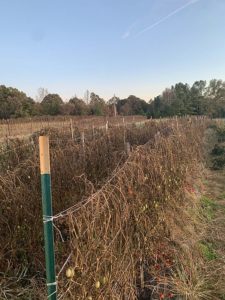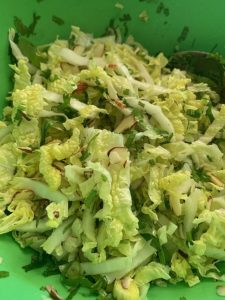It got real cold, y’all

On the last night of October the temperature dipped into the twenties and spelled doom for the tomatoes, pepper, and eggplant. It was time to say goodbye, anyway. Unfortunately, and quite unexpectedly, it also froze the broccoli and the bok choy, damaged all of the head lettuce, the salad mix, and burned the kale, collards, and other greens. Coming on the heels of wind and rain and 12 degrees colder than any previous night, the freeze did much more damage than I was prepared for. It is going to mean a little less diversity in the last few weeks of the CSA than I would have hoped.
It is hard to grow a fall garden when you don’t get much of a fall season. October came in with record highs kissing 100 degrees, and went out with an early hard freeze. Everyone jokes about how we don’t have a spring – that the weather goes straight from winter into summer. Because spring is so short, there are lots of veggies that we only grow in the fall because fall is more forgiving. Usually. Over the next few days we are looking at nights in the mid-twenties, which is 20 degrees below average and very close to record-breaking cold for this time of year.
There are always things that could be done differently with the gift of hindsight. Even so, I think we have done about as well as we could this fall with the wet July and August, the lingering summer heat, the armyworms and other pests, and now the early winter. There have been a lot of curve balls.
We are Building!

A new washing and packing facility is underway. This is a BIG project. Our current, open air wash-pack has lasted us eight years – since the year we first started the farm! This new facility should last forever. Post Harvest Handling is a big part of what we do. When you think about farmers, you may picture someone out in the field. Perhaps on a tractor or armed with a hoe. But the reality is that we farmers spend a significant portion of our time harvesting, washing and packing produce. You are more likely to see me with a harvest knife or pruners in my hands than any other tool. We hire part-time staff specifically to help with the massive workload in the wash-pack. It is important to have adequate space and an efficient facility to take in, handle and store the harvest as it comes out of the field.
Oh how we’ve grown
We built our current washing and packing area when we started the farm eight years ago. Our first year we had just 15 CSA shares, now we have 100! Our current wash-pack is like working in a tiny kitchen that forces one to constantly shuffle things around to find workspace. More than two people working in the wash-pack at a time is a circus. We lose things at the bottom of tall stacks in the walk in. During the peak summer season, packing the walk-in is like trying to pack the trunk of the family car for a two week vacation. We’ve made it work, but its a tight squeeze.
Bigger and Better
At 1200 square feet of indoor space and an additional 960 square feet of covered open air, the new wash-pack will be much bigger. The enclosed steel building will have a concrete floor to easily roll things around. Multiple walk-in cool rooms will allow us to store produce at different temperatures. Cucumbers, for example, need to be stored at a balmy 50 degrees while lettuce would prefer it at 33 degrees. The right temperature means better produce quality and vegetables that stay fresher longer. When we aren’t washing produce, we can use the building for winter building projects and other activities. We hope to be packing the first shares of 2020 in our new facility.
Eat like a farmer: Napa Cabbage Salad

No lettuce? No problem! Napa Cabbage thinly sliced makes a delicious salad green. I tossed it with fresh cilantro, green onions and slivered almonds, and dressed simply with olive oil, cider vinegar, salt and a squeeze of lemon.
I know what you are thinking; so many radishes! Daikon AND watermelon radish? We love to cut up and roast the watermelon radish along with other vegetables such as sweet potato, kohlrabi and and carrots. It is great in stir fry, and can be cut into slender matchsticks on a salad (see below for a recipe for the napa cabbage salad we had for lunch today). Watermelon radishes have become pretty popular, so you would be able to find lots more ideas online. Below is one Watermelon Radish recipe and several different recipes for daikon from different world cuisines.
Watermelon Radish, Orange and Goat Cheese Salad
Spicy Roasted Daikon “French Fries”
Mullangi Curry (South Indian Radish Stir-Fry)
Asian Chicken and Daikon Radish Soup
I am planning on trying a roasted daikon and sweet potato soup. I could find no such recipe so this is uncharted culinary territory! What are you going to do with your daikon? We want to know. Send us pictures! Post on Facebook and tag Tubby Creek Farm, or post on Instagram and tag @randy.tubbycreekfarm
Small Shares
- Napa Cabbage (or Cauliflower)
- Sweet Potatoes
- Carrots
- Daikon Radish
- Watermelon Radishes
- Mustard Greens
- Green Pepper OR Eggplant
Full Shares
- Napa Cabbage
- Sweet Potatoes
- Carrots
- Daikon Radish
- Watermelon Radishes
- Mustard Greens
- Collard Greens
- Green Peppers




You must be logged in to post a comment.